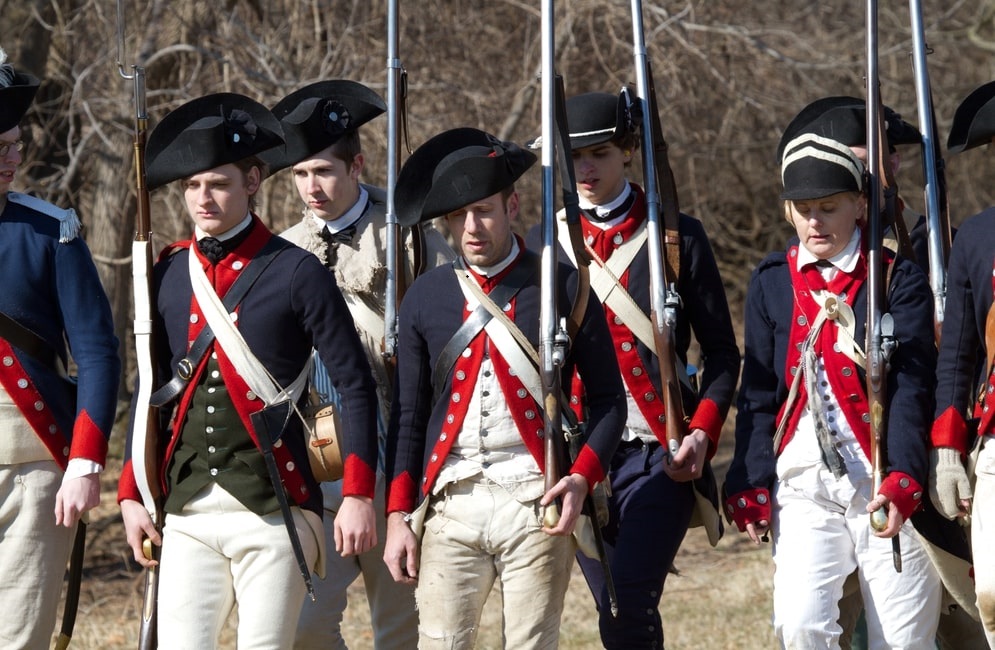Introduction: In this article – the first in a three-part series – Katie Rebecca Garner gives tips for researching your ancestor’s Revolutionary War pension. Katie specializes in U.S. research for family history, enjoys writing and researching, and is developing curricula for teaching children genealogy.
In this three-part series, I’m going to discuss a valuable resource for learning about the life of your Revolutionary War-era ancestor: pension records. In this first part, we’ll look at the history and processes of Revolutionary War pensions.
American colonists were tired of Britain’s tyrannical rule and wanted to govern themselves – or at least, have fair representation. But Britain wasn’t willing to let go of her colonies. Hence, the Revolutionary War was fought. The United States announced its independence to the world on 4 July 1776 when the Declaration of Independence was signed.

Photo credit: https://depositphotos.com/home.html
The Revolutionary War (1775-1783) lasted for eight years, and the soldiers who fought in the war and their families sacrificed much. Revolutionary War veterans were seen as local heroes, and it was appropriate that the U.S. government give back to them. Pensions were one way of giving back, which left a genealogically valuable paper trail.
The earliest pension records for Revolutionary War veterans were for those who were disabled in service. The earliest widows’ and orphans’ pensions were for family members whose husbands or fathers died in the war. As time went on, more money became available for pensions – but fewer veterans and widows were still alive. This resulted in the laws changing to become less restrictive, thus qualifying more people for a pension.
When looking at an ancestor’s pension, look for the pension act mentioned in the pension papers. Most likely, this was the pension act which made your ancestor eligible for a pension. For example, in the case of Jacob Long of Lancaster, Pennsylvania, this was the act of 7 June 1832, which will be discussed shortly.
Pensions given in 1776 were based on disability incurred in the war. In 1806, pensions were expanded to disabled state troops and militia. Beginning in 1818, a pension was available to any veteran who had served at least nine months with or without disability. Because too many people were applying for this, it was modified in 1820 so that applicants had to prove need. In 1832, pensions were granted to veterans who served at least six months. Those who served longer than two years were given full pay while those who served less than two years were given half pay.
This 1832 act didn’t require the veteran to demonstrate need. By then, many who had served in the Revolutionary War were dead, but not all who were living were able to prove six months of service. Jacob Long was able to prove service of over six months to receive a pension of $31.09 per year. Prior to the act of 1832, he didn’t qualify for a pension.
Photo credit: https://depositphotos.com/home.html
Meanwhile, changes in eligibility occurred for widows’ pensions. Widows and orphans of deceased and disabled soldiers were granted a pension beginning in 1780. An act in 1818 provided a pension for widows and orphans of wars prior to 1818 (including both the Revolutionary War and War of 1812). In 1836, the widow had to be married to the soldier prior to the end of his service. Two years later, widows who married prior to 1794 were entitled to half pay. Acts occurring in 1843, 1844, and 1848 changed the required marriage date. Such changes resulted in younger and younger widows qualifying for a pension. In 1853, all restrictions on marriage date were removed. This meant that a young woman could marry an old, rich pensioner, and receive a widow’s pension after he died. In 1878, widows of soldiers who served at least 14 days qualified to receive a pension for life. By this time all Revolutionary War soldiers had died.
A change regarding the need of pensioners occurred in 1820. Previously, the veteran decided if he was poor enough to need a pension. Sometimes the Secretary of War would decide a pensioner was not poor enough and strike them off the pension rolls. The act of 1820 defined what level of poverty qualified one for a pension. An act of 1823 restored pensions to those who were struck off the role but had since become indigent. In 1828, applicants were no longer required to demonstrate need.
Both federal and state pensions existed. The state might have granted a pension where the federal government wouldn’t, such as a widow whose husband’s service didn’t qualify. In addition, there were private relief acts. These came about by a veteran or a widow writing to their congressman requesting help.
Not all pension applicants were granted a pension. Some were rejected for various reasons and would work to prove they were worthy of a pension. Reasons for a pension being rejected included marriage after service (or after the required marriage date), lack of service, or the soldier deserting the army. More on this will be discussed in an upcoming article in this series.
The process of applying for a pension involved the soldier appearing in a court in the state where he resided and describing his service. He had to include his place of enlistment, his commanding officer, and the length of service. Witnesses, including neighbors and fellow soldiers, testified about the soldier’s service. In the case of a widow’s pension, the widow had to provide this information and provide proof of her marriage to the deceased soldier.
Once the pension was approved, a set annual amount would be determined, which the pensioner could pick up from the War Department office twice a year. A final payment was often made to the heirs of the pensioner, which consisted of the amount owed between the last payment picked up and the time of the pensioner’s death. Sometimes this happened decades after the death.
The next article in this series will cover what you can find in a pension record.
Explore over 330 years of newspapers and historical records in GenealogyBank. Discover your family story! Start a 7-Day Free Trial
Note on the header image: “Washington Crossing the Delaware” by Emanuel Leutze, 1851. Credit: The Metropolitan Museum of Art; Wikimedia Commons.
Resources:
- https://www.familysearch.org/rootstech/session/1-find-and-use-revolutionary-war-records
- https://www.familysearch.org/rootstech/session/2-finding-your-ancestor-in-pension-and-bounty-land-files
- https://familytreewebinars.com/webinar/american-revolution-genealogy/?category=records&subcategory=military&subsubcategory=revolutionarywar&sortby=newest
- https://familytreewebinars.com/webinar/revolutionary-war-series-4-of-5-records-created-by-the-revolutionary-war-after-the-war-pensions/?category=records&subcategory=military&subsubcategory=revolutionarywar
- Jacob Long pension file, pension no. 3434, U.S. Revolutionary War, NARA publication M804, record group 15, roll 1580; digital image, fold3 (https://fold3.com: accessed 8 November 2022), 37 pages.
